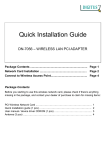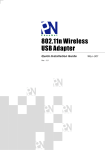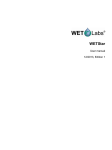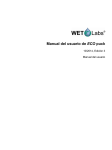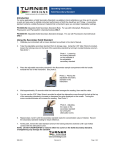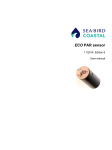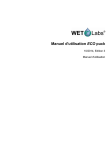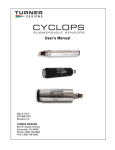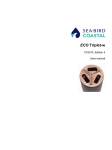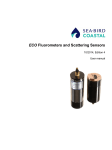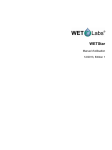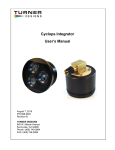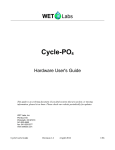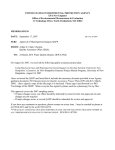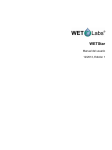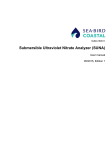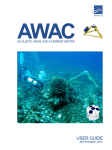Download ECO puck user manual
Transcript
ECO puck user manual 10/2014, Edition 3 User manual Table of Contents Section 1 Specifications .................................................................................................................... 3 1.1 Mechanical................................................................................................................................... 3 1.1.1 Puck bulkhead connectors.................................................................................................. 3 1.2 Electrical....................................................................................................................................... 3 1.3 Communication............................................................................................................................ 4 1.4 Optical.......................................................................................................................................... 4 1.4.1 Single-parameter fluorometer..............................................................................................4 1.4.2 Single-parameter scattering................................................................................................ 4 1.4.3 Two-parameter fluorometer-turbidity................................................................................... 4 1.4.4 Three-parameter fluorometer and scattering.......................................................................4 Section 2 Operation and maintenance ........................................................................................... 5 2.1 Verify sensor operation................................................................................................................ 5 2.2 Set up puck for deployment......................................................................................................... 6 2.3 Save data..................................................................................................................................... 6 2.3.1 Save data to host PC.......................................................................................................... 6 2.4 Sensor maintenance.................................................................................................................... 7 Section 3 Reference topics ............................................................................................................... 9 3.1 Delivered items............................................................................................................................ 9 3.1.1 Test cable............................................................................................................................ 9 3.2 Calibration.................................................................................................................................... 9 3.3 Characterization........................................................................................................................... 9 3.4 Terminal program operation......................................................................................................... 9 3.4.1 Common terminal program operations.............................................................................. 10 Section 4 General information ....................................................................................................... 11 4.1 Warranty..................................................................................................................................... 11 4.2 Service and Support................................................................................................................... 11 4.3 Waste electrical and electronic equipment................................................................................. 11 1 Table of Contents 2 Section 1 Specifications 1.1 Mechanical There are many different sizes of ECO pucks. The most common are specified below. Diameter Length Depth rating 6.30 cm 5.683 cm 6.937 cm 5.147 cm 7.62 cm 5.72 cm Temperature range Weight in air, water 0.235 kg, 0.235 kg 600 m 0.261 kg, 0.261 kg 0–30 °C 600 m 1000 m 0.282 kg, 0.282 kg 1.1.1 Puck bulkhead connectors ECO pucks use different bulkhead connectors. The most common are shown below. Contact Function 1 Ground 2 RX 3 Reserved 4 Voltage in 5 TX 6 Reserved Contact MCBH-6-MP Function 1 Ground 2 RX 3 Reserved 4 Voltage in 5 TX 6 Reserved Pin LPMBH-6-MP Function 1 Reserved 2 Voltage in 3 TX 4 RX 5 Reserved 6 Ground Internal Molex connector 1.2 Electrical Input Current draw Linearity 7–15 VDC 60 mA 99% 3 Specifications 1.3 Communication Sample rate Output rate Output maximum Output resolution to 4 Hz 19200 baud 4130 ±30 counts 12 bit 1.4 Optical 1.4.1 Single-parameter fluorometer Parameter Wavelength EX/EM Range, Sensitivity Chlorophyll (Chl) 470/695 nm 0–125, 0.016 µg/L Colored Dissolved Organic Matter (CDOM) 370/460 nm 0–500, 0.093 ppb Uranine (UR) 470/530 nm 0–400, 0.05 ppb Phycocyanin (PC) 630/680 nm 0–230, 0.029 ppb Phycoerythrin (PE) 540/570 nm 0–230, 0.029 ppb Parameter Wavelength Range, Sensitivity Scattering 470 nm, 532 nm, 650 nm 0–5, 0.003 m-1 700 nm 0–3, 0.002 m-1 1.4.2 Single-parameter scattering 0–5, 0.003 m-1 1.4.3 Two-parameter fluorometer-turbidity Parameter Wavelength EX/EM Range, Sensitivity (chl) Parameter Wavelength Range, Sensitivity (NTU) Chlorophyll 470/695 nm 0–30, 0.015 µg/L NTU 700 nm 0–10, 0.005 NTU 0–50, 0.025 µg/L 0–25, 0.013 NTU 0–75, 0.037 µg/L 0–200, 0.098 NTU 0–125, 0.062 µg/L 0–350, 0.172 NTU 0–250, 0.123 µg/L 0–1000, 0.123 NTU 1.4.4 Three-parameter fluorometer and scattering Parameter Wavelength EX/EM Range, Sensitivity Chlorophyll (Chl) 470/695 nm 0–30, 0.015 µg/L 0–50, 0.025 µg/L Colored Dissolved Organic Matter (CDOM) 370/460 nm 0–375, 0.184 ppb Uranine (UR) 470/530 nm 0–300, 0.073 ppb Phycocyanin (PC) 630/680 nm 0–175, 0.086 ppb Phycoerythrin (PE) 540/570 nm 0–175, 0.086 ppb Parameter Wavelength Range, Sensitivity Scattering 412 nm, 470 nm, 532 nm, 650 nm, 880 nm 0–5, 0.003 m-1 700 nm 0–3, 0.002 m-1 0–5, 0.003 m-1 4 Section 2 Operation and maintenance 2.1 Verify sensor operation WARNING CDOM sensors use an ultraviolet LED light. Do not look directly at a UV LED when it is on. It can damage the eyes. Keep products that have UV LEDs away from children, pets, and other living organisms. Wear polycarbonate UV-resistant safety glasses to protect the eyes when a UV LED is on. CAUTION Do not supply more than 15 VDC to the sensor. More than 15 VDC will damage the sensor. Make sure that the sensor operates before further setup and deployment. 1. Connect the 6-contact connector on the optional test cable (refer to the section on the Test cable on page 9 for details) to the sensor. 2. Remove the cap that protects the optical face of the sensor. 3. Connect a serial-to-USB adapter to the test cable to connect the test cable to the host PC. 4. Connect the sensor to a power supply. a. Connect sensors with internal batteries to the manufacturer-supplied, threecontact, blue-tipped power connector. The sensor comes on. b. Connect sensors without internal batteries to the optional test cable and a regulated power supply set at 12 VDC. 5. Start the host software from the manufacturer-supplied CD. a. Select the COM port on the host PC. b. Select the device file for the sensor from the CD. c. Select the baud rate if necessary. The default is 19200. 6. Turn on the power supply. The sensor comes on. 7. Push Start Data on the host software. 8. Go to the Raw Data tab of the host software. The data collected by the sensor shows in the "Signal" column. Note that RT and puck sensors show 9's instead of the Date and the Time. Figure 1 Format of data collected by real-time sensors 5 Operation and maintenance 9. Look at the maximum data value for the sensor. Hold a finger, the protective cap, or fluorescent stick if the sensor is a fluorometer, 1–4 cm away from the optical face of the sensor. The data value in the "Signal" column in the Raw Data tab will increase toward the maximum data value specified for the sensor. • Scattering and turbidity sensors: use a finger or the protective cap. • CDOM sensors: use the blue fluorescent stick. • Chlorophyll or phycoerythrin sensors: use the orange fluorescent stick. • Uranine or phycocyanin sensors: use the yellow fluorescent stick. • PAR sensors: point the sensor into the light. 10. Push Stop Data. The Bio-wiper closes on sensors so-equipped. If the power is turned off in mid-cycle, the Bio-wiper starts at the beginning of the cycle when power is supplied again. 2.2 Set up puck for deployment 1. 2. 3. 4. Refer to the previous section to make sure that the sensor operates correctly. Replace the test cable with a sea cable for deployment. Remove the protective cap from the sensor if necessary. Make sure that the sensor has a power source. 2.3 Save data Save the data collected by the sensor in the sensor's memory (if so equipped), on the host PC, or both. Note: RT and puck sensors do not store data. Save the data from these sensors in real-time to the host PC or to a data logger. 2.3.1 Save data to host PC To save data to the host PC in counts, push Record Raw. To save data in engineering units, push Record Engr. Data collected by the sensor is saved in real-time to the host PC. 1. Push Record Raw. The Record Raw Data window shows in the host software. 2. Select a location on the host PC to store the data. 3. Type a file name. 4. Push Save. 5. Push Record Engr. The Record Engineering Data window shows in the host software. 6. Select a location on the host PC to store the data. 7. Type a file name. 8. Push Save. 6 Operation and maintenance 9. Make sure the PC is configured to save data. • The file names from step 3 and step 7 will show in the host software. 10. Push Start Data. The host software will show the host PC file sizes. 2.4 Sensor maintenance CAUTION Do not use acetone or other solvents to clean any part of the sensor. 1. After each cast or exposure to natural water, flush the sensor with clean fresh water. 2. Use soapy water to clean any grease or oil on the optical face of the sensor. It is made of ABS plastic and optical epoxy and can be damaged if an abrasive cleaner is used. 3. Dry the sensor with a clean soft cloth. 7 Operation and maintenance 8 Section 3 Reference topics 3.1 Delivered items • • • • • • • • • • the ECO sensor a dummy connector and lock collar blue-tipped power connector and lock collar for sensors with internal batteries a plastic protective cover for the optical face a model-specific spare parts kit On the CD: this user manual the ECOView host software the device file or files for the sensor the characterization or calibration page for the sensor. 3.1.1 Test cable Use a test cable to set up and test the sensor before deployment. 1 six-contact connector 3 db-9 serial port connector 2 9-volt battery connector 1. Connect the six-contact connector into the sensor. 2. Connect the 9-volt connector to a 9-volt battery. As an alternative, it can be connected to a regulated power supply. 3. Connect the db-9 connector to the host PC. Use a USB-to-RS232 adapter cable if necessary. 3.2 Calibration The manufacturer calibrates all scattering sensors to make sure that the data that is collected meets the sensor's specifications. This information is on the sensor-specific calibration page that comes with the sensor. 3.3 Characterization The manufacturer uses a fluorescent material to characterize all fluorescence sensors to make sure that the data that is collected meets the sensor's specifications. This information is on the sensor-specific characterization page that comes with the sensor. 3.4 Terminal program operation Use Windows HyperTerminal® or other terminal program to operate sensors as an alternative to the host software. Interface settings baud rate: 19200 stop bits: 1 data bits: 8 flow control: none parity: none 9 Reference topics 3.4.1 Common terminal program operations Command Parameters !!!!! none Stops data collected by the sensor. Lets the user to enter setup values. If the sensor is in a low-power mode, turn the power supply off for one minute, then turn the power on and push the "!" key 5 or more times. $ave 1–65535 The number of measurements that make up each row of collected data. $mnu — Prints the menu of setup values to the host PC screen. $pkt 0–65535 Sets the number of rows of data that are collected between the specified time intervals. $run — Uses the current setup values to operate. $sto — Saves the desired setup values to the sensor's flash memory. 10 Description Section 4 General information Revised editions of this user manual are on the manufacturer's website. 4.1 Warranty This sensor is warranted against defects in materials and workmanship for one year from the date of purchase. The warranty is void if the manufacturer finds the sensor was abused or neglected beyond the normal wear and tear of deployment. 4.2 Service and Support The manufacturer recommends that sensors be sent back to the factory annually to be cleaned, calibrated, and for standard maintenance. Refer to the website for FAQs and technical notes, or contact the manufacturer for support at: [email protected] Do the steps below to send a sensor back to the manufacturer. 1. Contact the manufacturer for a Return Merchandise Authorization (RMA). Note: The manufacturer is not responsible for damage to the sensor during return shipment. 2. Remove all anti-fouling treatment from the sensor before sending it back to the manufacturer. Note: The manufacturer will not accept sensors that have been treated with anti-fouling compounds for service or repair. This includes tri-butyl tin, marine anti-fouling paint, ablative coatings, etc. 3. Use the sensor's original ruggedized shipping case to send the sensor back to the manufacturer. 4. Write the RMA number on the outside of the shipping case and on the packing list. 5. Use 3rd-day air to ship the sensor back to the manufacturer. Do not use ground shipping. 6. The manufacturer will supply all replacement parts and labor and pay to send the sensor back to the user via 3rd-day air shipping. 4.3 Waste electrical and electronic equipment Electrical equipment that is marked with this symbol may not be disposed of in European public disposal systems. In conformity with EU Directive 2002/96/EC, European electrical equipment users must return old or end-of-life equipment to the manufacturer for disposal at no charge to the user. To recycle, please contact the manufacturer for instructions on how to return end-oflife equipment, manufacturer-supplied electrical accessories, and auxiliary items for proper disposal. 11 General information 12 WET Labs, Inc. P.O. Box 518 Philomath, OR 97370 U.S.A. Tel. (541) 929-5650 Fax (541) 929-5277 www.wetlabs.com © WET Labs, Inc. , 2013. All rights reserved. Printed in U.S.A.
















